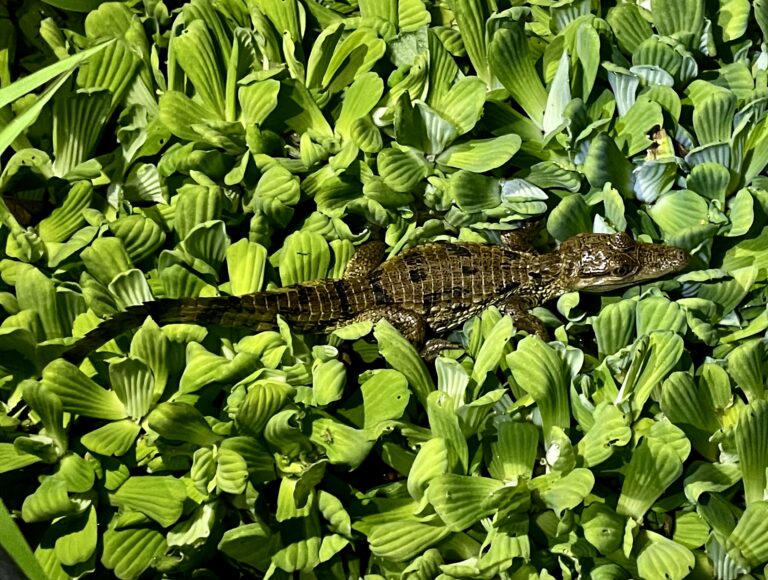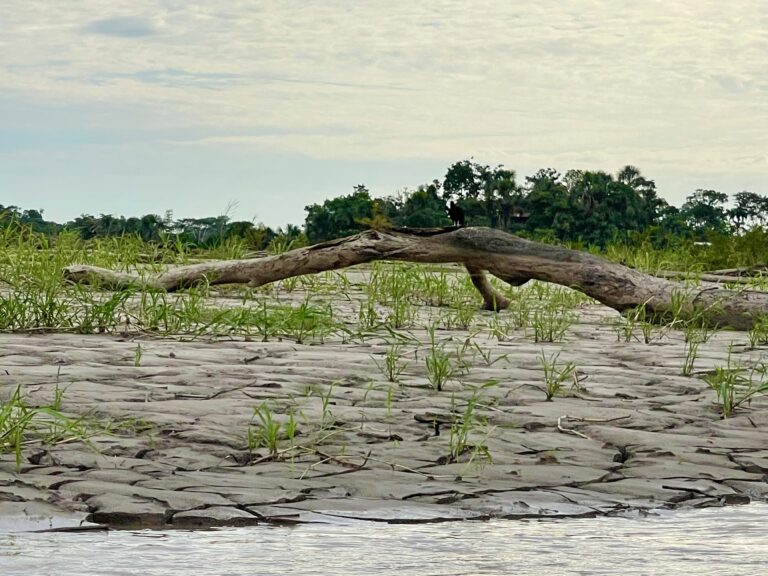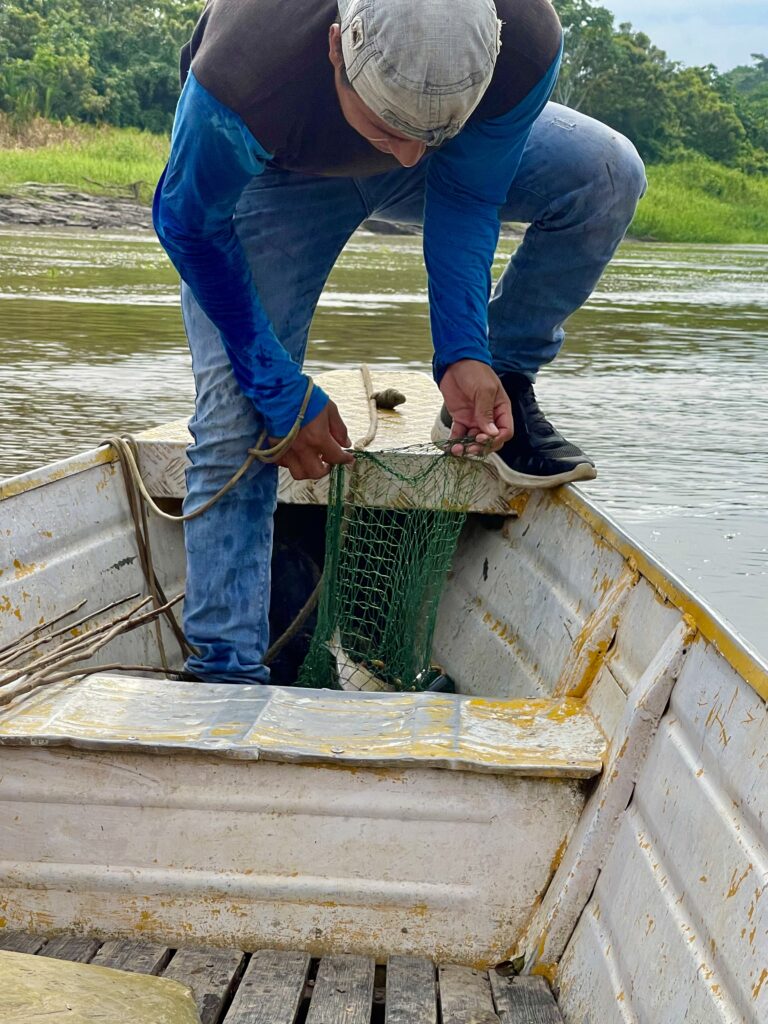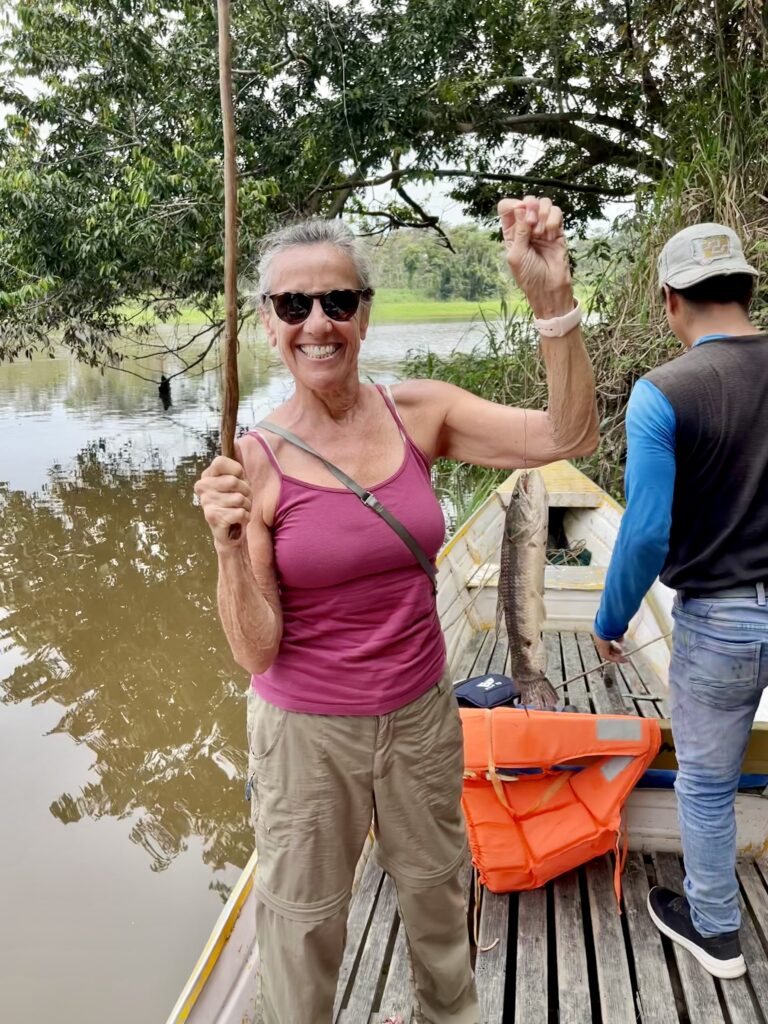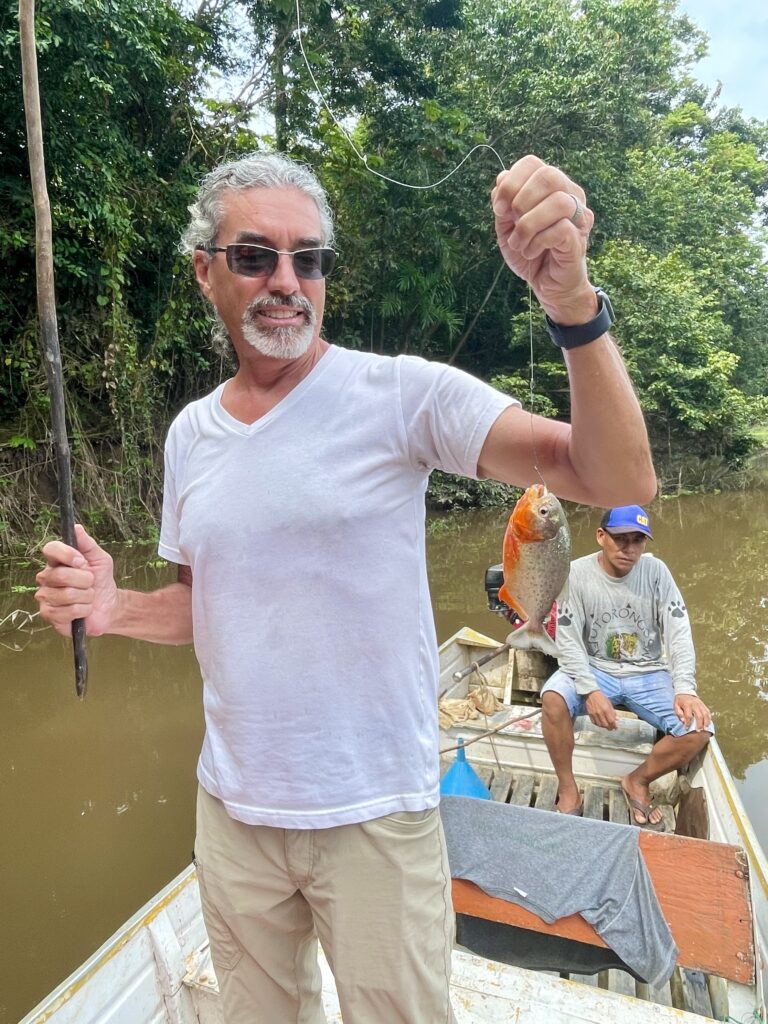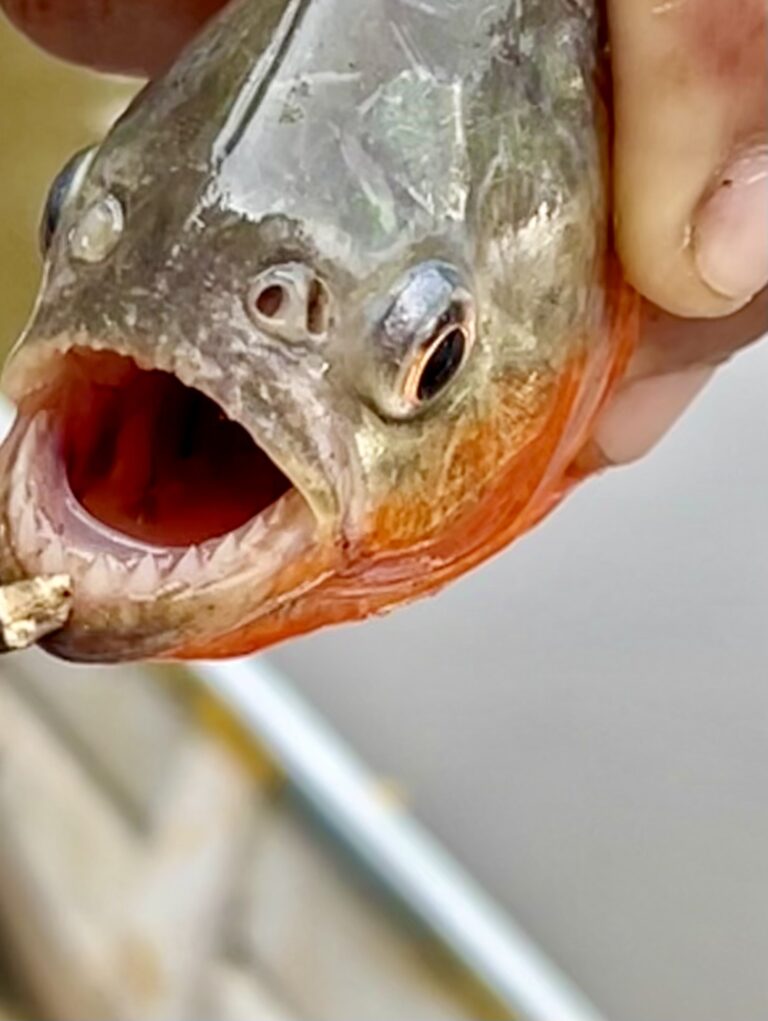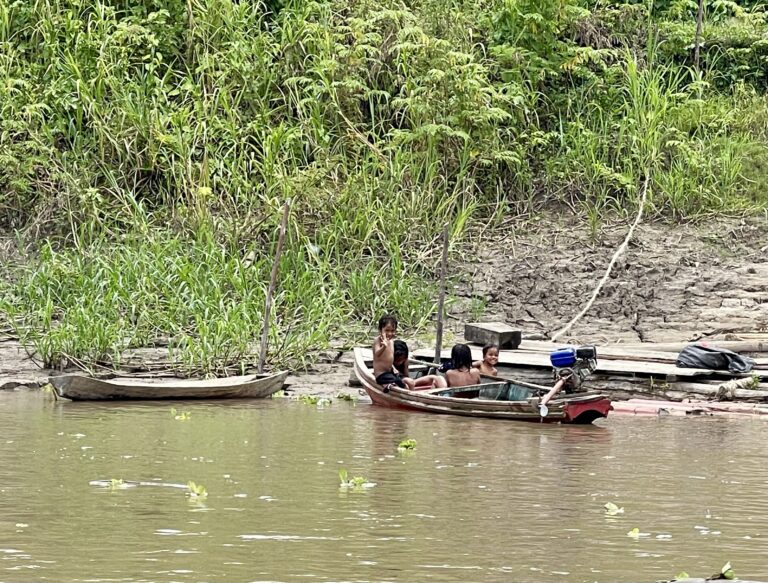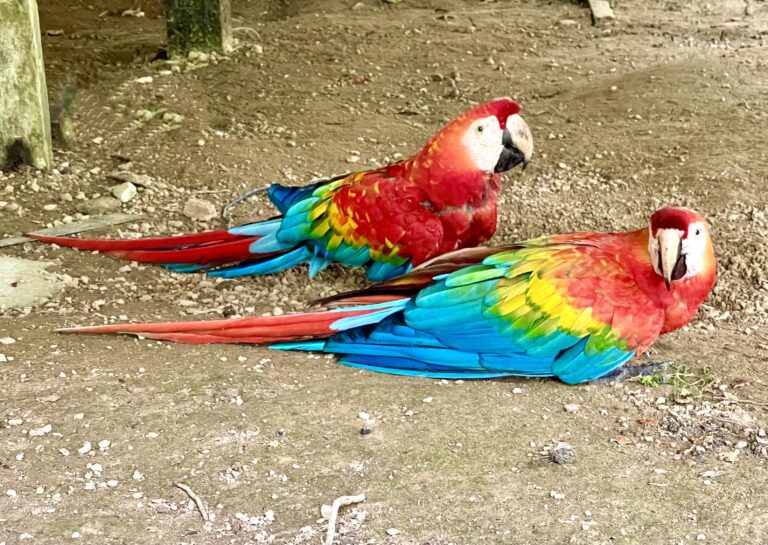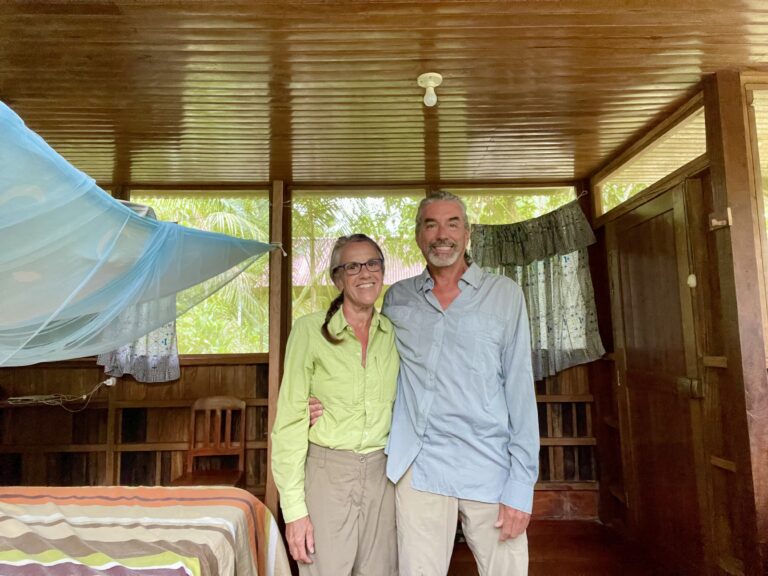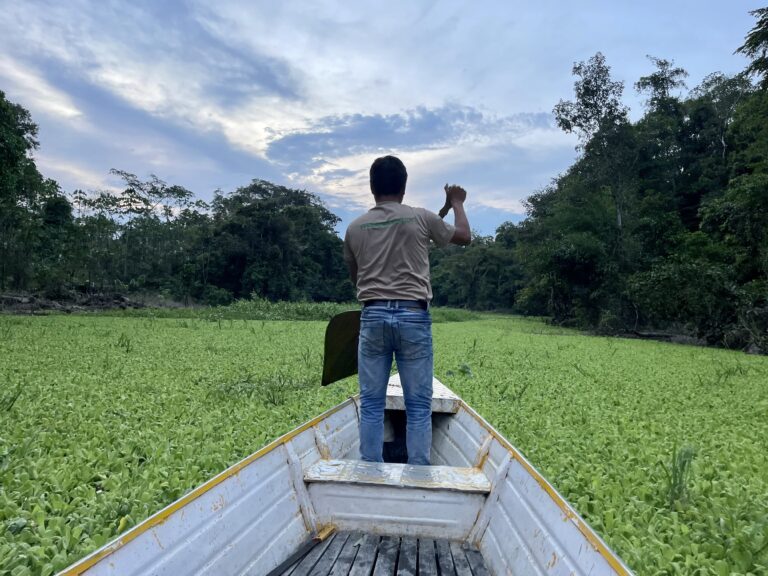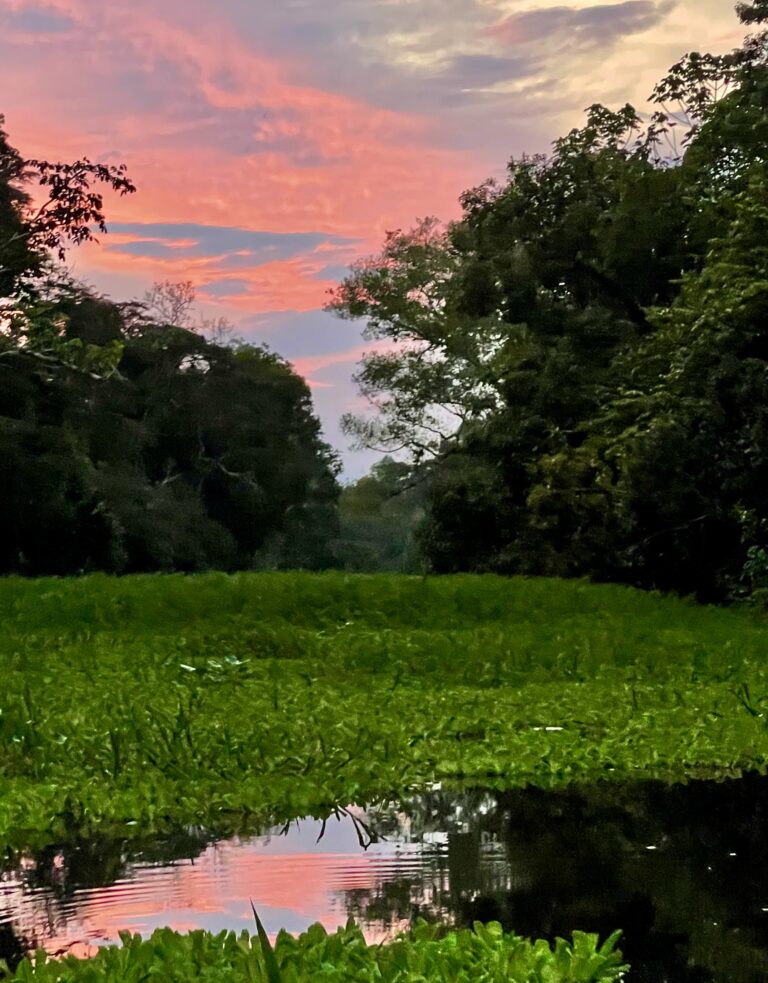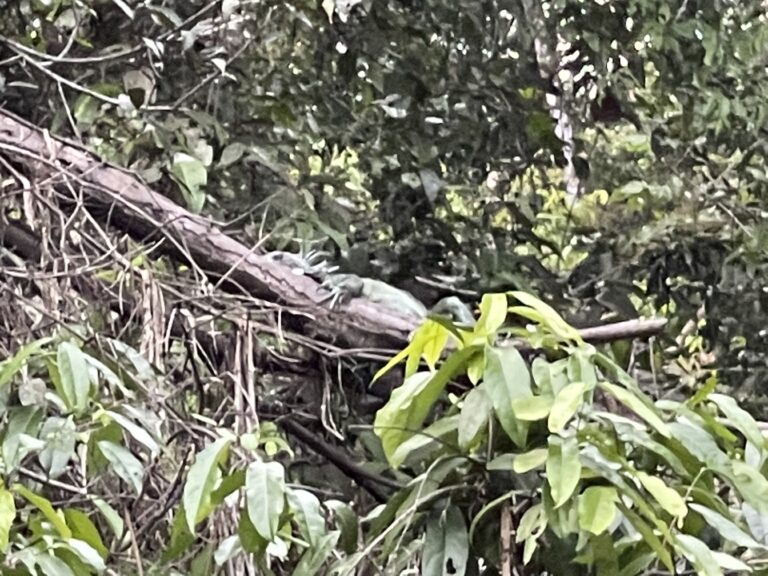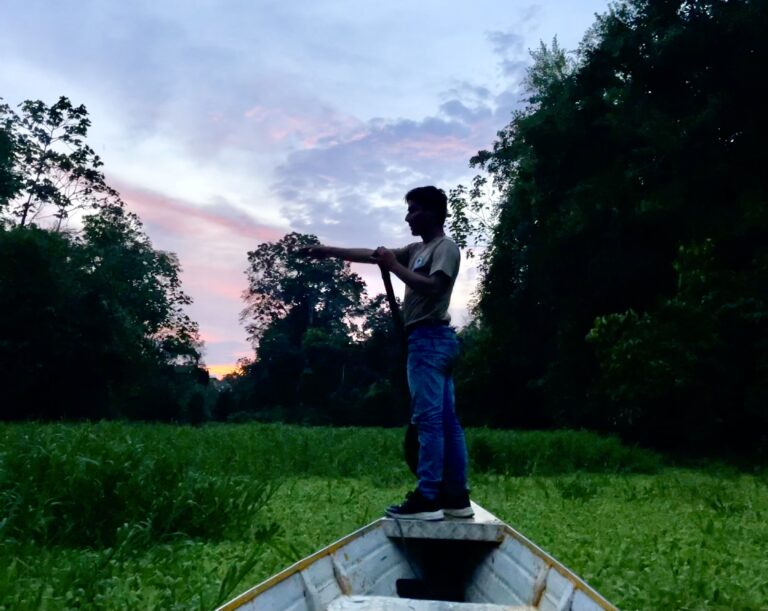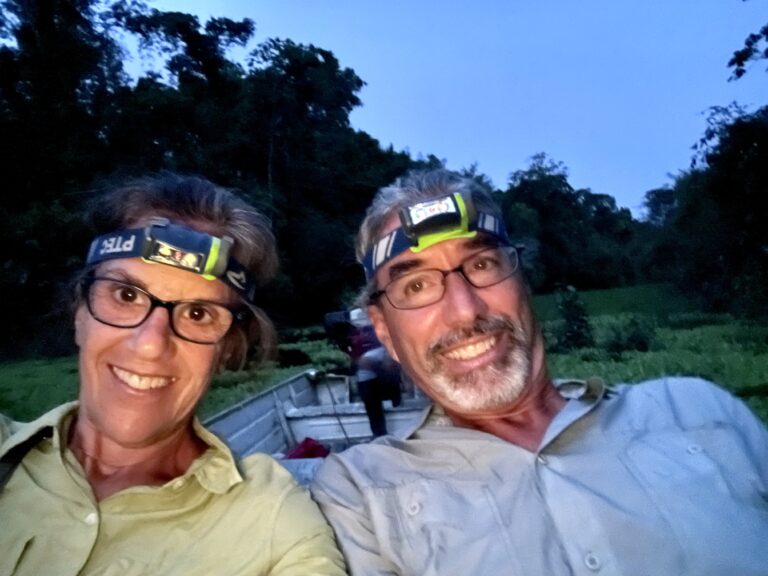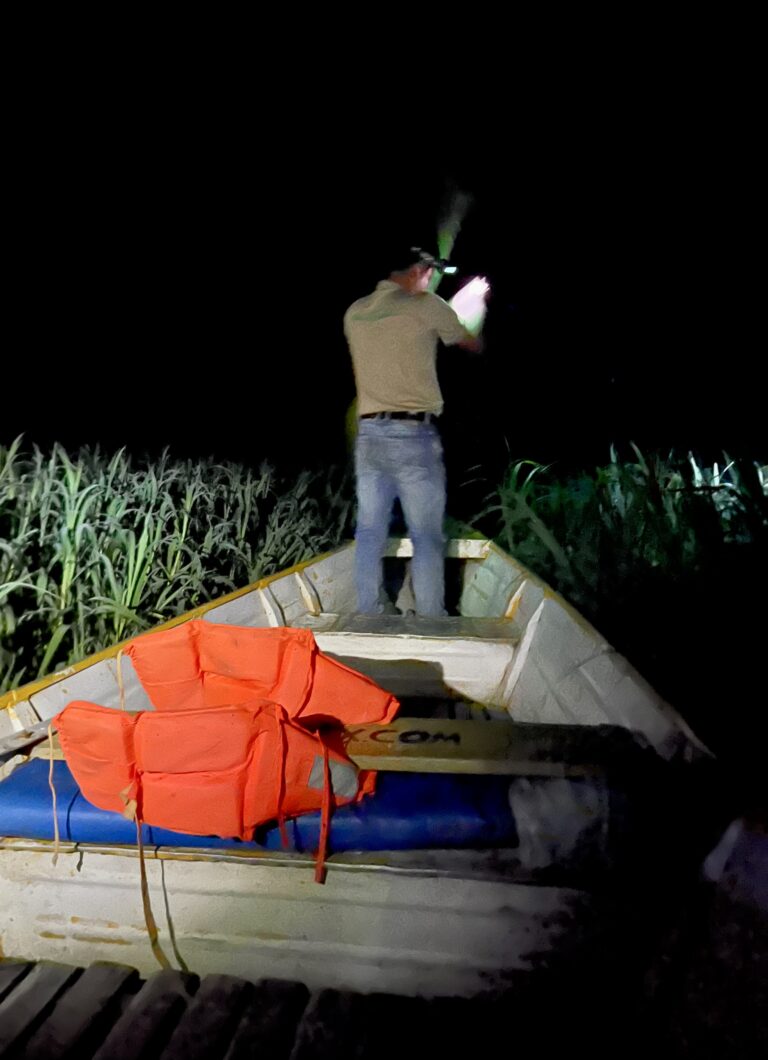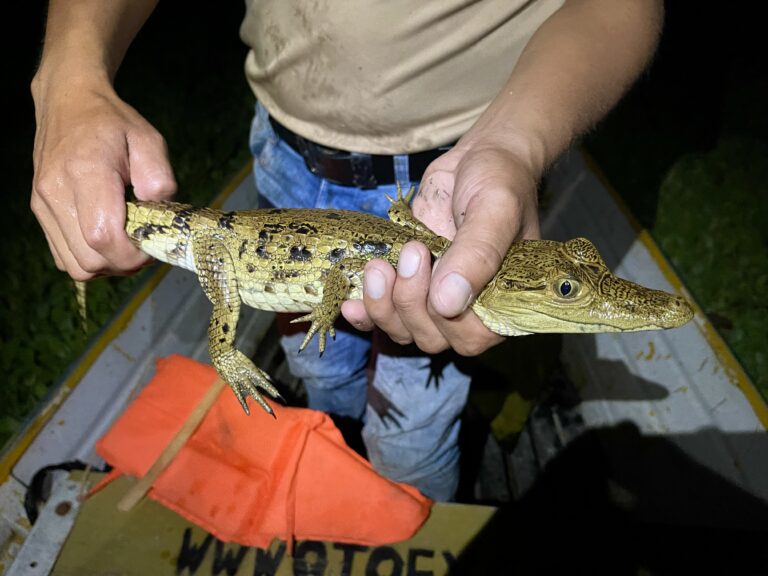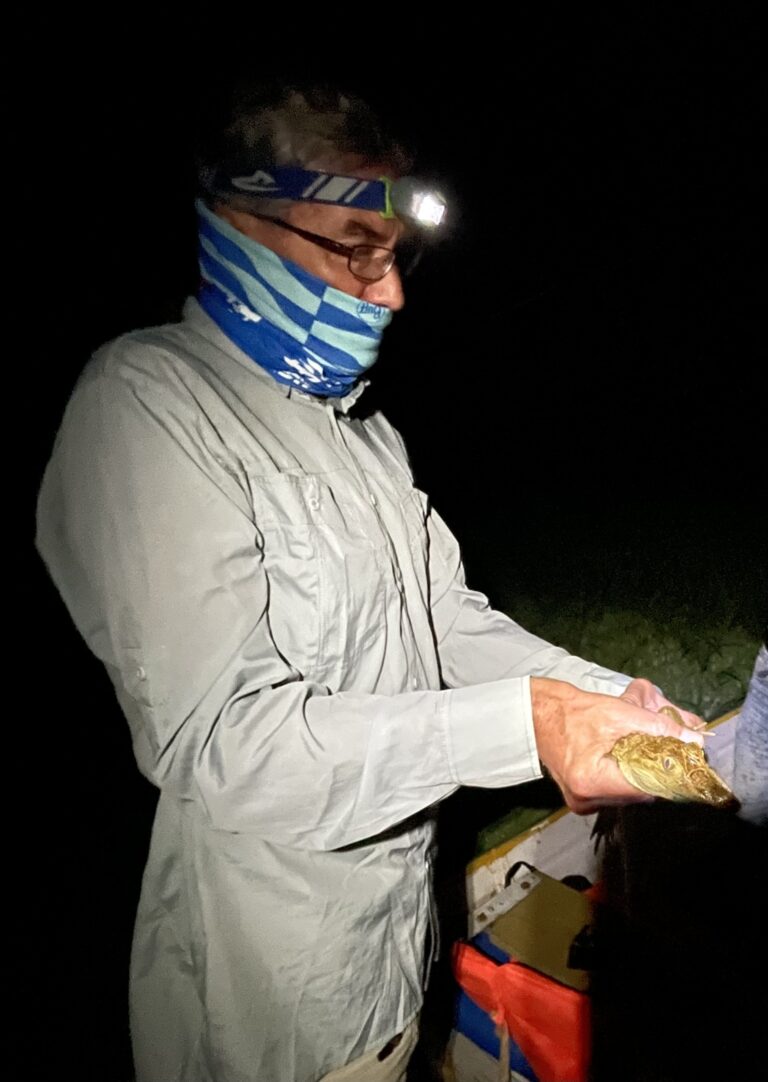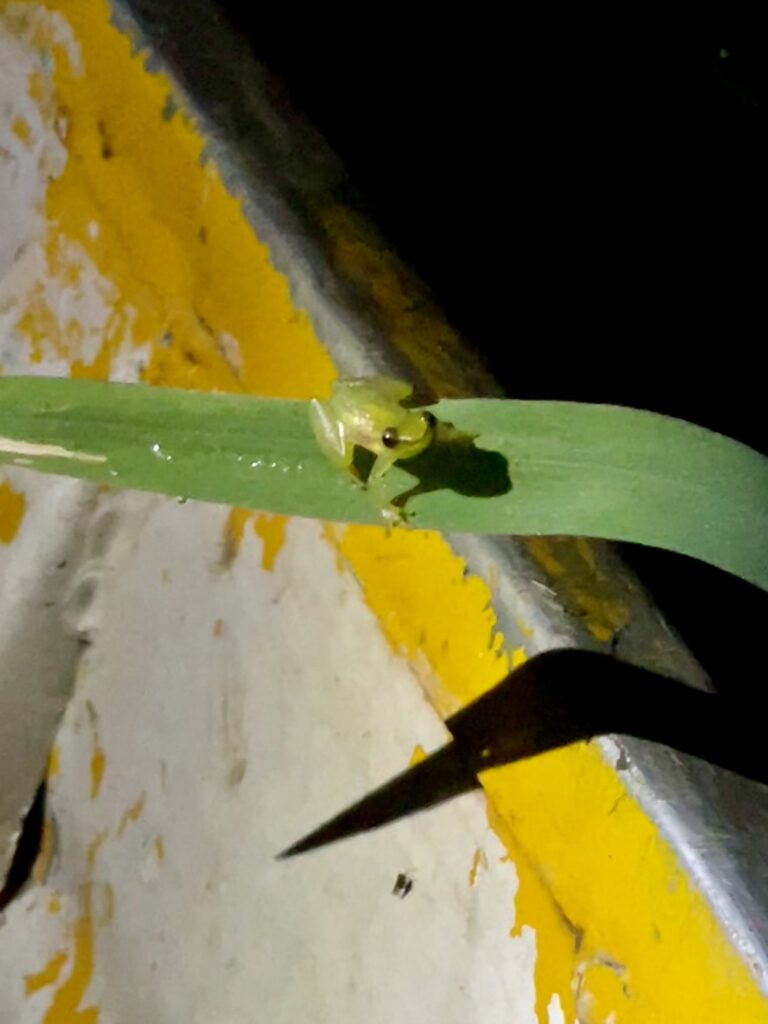February 2, 2022
It was February but that’s summer south of the equator and it was hot. Even overnight it probably never went below 90°F, so we slept without even a sheet over us—though we did keep the mosquito netting down over the bed. Morning dawned cloudy, which was a nice change. After another large breakfast, we set out on the pecky-pecky to go fishing in the Amazon River. We crossed the wide Amazon again, dodging logs of all sizes along with the ever-present water lettuce.
We crossed the wide Amazon again, dodging logs of all sizes along with the ever-present water lettuce. Once on the other side, we entered a type of lagoon and stopped at a spot where we’d get bait for our fishing expedition. Just then, more pink dolphins appeared, close enough to catch one on video (well, sort-of and very briefly).
While we sat in the boat in the lagoon, refrigerator-sized chunks of river bank eroded and fell into the water before our eyes. Jón explained the erosion and large swaths of sediment were due to abnormal river level fluctuations in recent years.
Fortunately, a wind had come up from the east, cooling us as we headed up the lagoon until it turned into another small river, this tributary not muddy like the Amazon, but dark with tannin. Up the river a few miles we pecky-peckied along at about five or six knots, the Honda and skipper working hard, to reach one of the best fishing spots. Eventually, we stopped in the shade of some overhanging trees. While stopped, it was stiflingly hot so we took off our long-sleeved shirts, which I’d regret later while I itched in our cabin. Susan had covered her arms and neck in 100% DEET but I (incorrectly) thought I’d be okay without for a little while.
Jón brought out several traditional, basic fishing poles—slender sticks about six feet long, with six feet of fishing line, a small weight and a small hook. As we put the bait on the hooks and cast into the shadows, we got bites almost immediately. And no wonder—Jón had taken us to a place teeming with fish, incuding red-bellied pirahnas.
Susan surprised us all by quickly landing a foot-long catfish with sharp spines and she squealed with delight—it would be the biggest catch of the day. Jón said the river bottom was filled with catfish and they were a staple for local villagers; we’d eat fresh-caught catfish at least once a day at the lodge.
Some of the catfish in the river were easily three feet long, Jón said, and there was no way would our light gear could bring them up. We had several more catfish strikes but no landings.
But then, ravenous piranhas began hitting our bait. It seemed like every time we cast with the primitive rigs, we could feel something striking, sometimes nonstop, as the piranhas swarmed and we frequently brought up bare hooks. The trick, we quickly discovered, was to move the bait slowly through the dark water until a piranha would strike hard, then set the hook and bring it up where it dared us to get close to its teeth. As soon as I cast that way, I got a piranha strike! Unhappy being caught, the piranha snapped its razor-sharp teeth as we removed the hook.
Over the next half hour or so, we hauled in more angry piranhas that, in a reversal of their fortune, would be part of lunch at the lodge. I knew there would be little meat on the fish, but how often do you get to catch and eat such fearsome little creatures?
After catching plenty of fish we headed back down the tributary. We passed young boys fishing from small wooden boats, some with only paddles, not engines. We also saw several groups of young boys playing at the water’s edge. Jón told us that we were seeing so many children because they were currently out of school for a month. The reason school was closed, he explained, was because the one and only teacher in the nearby village was away on a vacation. We also noticed that there were no little girls out playing, though it wasn’t obvious why.
Clouds were building as we crossed the mile-and-a-half wide Amazon again, then hugged the shore as long as possible as a one- or two-foot chop had come up. I had even more respect for Saul as he navigated around acres of floating trees and miles of floating water lettuce in the chop.
Back at the lodge, we had a lunch of catfish and our fresh-caught piranha which, though very tasty, didn’t have much meat. During lunch, Jón asked if we wanted to head up a long tributary of the Amazon that night, looking for caimans. Hmm, dark, no lights, no safety gear and caimans. What could go wrong? But we figured we’re too old to die young now, so why not? Dinner would be late, Jón said, as the caimans don’t come out until after the sun sets.
Meanwhile, we returned to our cabin and were greeted by the resident macaws who sat resting on the ground by the stairs. We looked forward to our usual cold afternoon showers but the water tank had run dry. At least we were having a longer-than-usual siesta since we’d have an evening activity rather than an afternoon one. After a few hours, the lodge’s small gas-powered pump refilled the tank from the river and we finally showered.
At 5 p.m., we loaded up in the pecky-pecky. We had no idea what this adventure would be like as Saul, ever the competent captain, guided the boat upstream for maybe a half hour then turned up another, smaller tributary of the Amazon.
As the sun was starting to set, we came to what looked like a cornfield dead ahead and on both sides of us. Instead of stopping, Saul gunned the little engine and we powered through while Jón, standing at the bow, guided us into a narrow channel of clearer water. Soon, the high grasses thickened and the engine slowed as the prop dug into the grass. We kept inching forward for a few hundred yards until our progress was stopped and we assumed we’d go no farther.
It was a brief reprieve. Soon we were in the grasses again and the boat struggled. We were sure we were stuck as the Honda engine could give no more. Jón seemed nonplussed as he alternated between hacking the tree branches and the three-feet high grasses with the machete. We tried again with Jón using a large paddle to help, but we still were not moving.
I picked up a second paddle and helped Jón push through the grass as the engine howled and the prop churned the tough grass. We crept along this way for several minutes before the next clear water, then repeated the process again, eventually having to clear our way through giant patches of water lettuce too.
As we slogged along, Saul noticed a large iguana creeping along a branch above the shoreline. It was well-camouflaged but when Jón directed the boat closer we finally saw it. We were amazed at Saul’s eyesight and observation skills—there wasn’t much daylight, the iguana was almost completely camouflaged, and Saul spotted it even while also working hard to keep the boat moving through the unfriendly river.
By now it was getting dark and we knew that although getting through the thick grass, water lettuce and overhanging vines was tough now it would be an even a greater challenge once it was dark. Yet onward we went. A couple of times Jón spotted a small caiman but it slithered under the thick carpet of grass and lettuce before we could see it.
We pressed on and Susan and I both felt a little anxious as we knew we had a long way back and by then it would be completely dark. We had to have 100% trust in these two men who we hardly knew. No one back home knew even close to where we were and I could tell there was no backup plan if the engine failed or someone got hurt.
Then we (nervously) laughed at how great a horror movie this would make: This is where we’ll dump the bodies after we chop them up with machetes. The caiman will finish the rest….
Once the sun went down completely, we stopped. Jón described how the caiman lived and that the babies mostly inhabited this area, though their much larger mother was likely nearby and the young could summon her with their call.
Jón attached a bright light to his headband and we moved slowly ahead through a carpet of grasses and water lettuce. There was no way we’d come this far and not see a caiman. Jón was determined.
Suddenly, Jón excitedly pointed out red glowing eyes in the grasses just ahead of our boat. A small caiman! Saul moved the boat slowly and quietly toward the caiman, who was mesmerized by the light. To our surprise, Jón leaned way over the bow and grabbed the caiman by the throat and belly and lifted him up triumphantly. It was an amazing feat taking supreme teamwork. In the darkness with our headlamps, we examined him. He was just a baby and looked much like a small American alligator. There are several types of caiman but the type found in the Amazon are black caimans—the largest caimans and the apex predator of the Amazon. By adulthood, Amazonian caimans grew to be as much as 16-20 feet long (which is just slightly smaller than American alligators).
It was inky black with no moon and a few fuzzy stars above when we turned the boat around. We had no idea how they’d navigate back through the grasses and dark water, but they worked as a team and it was obvious they’d been here before, though as Jón later told us, the grasses were much higher than they expected. The normal rains were supposed to have raised the river level high enough to submerge the grasses but it hadn’t happened this year.
Millions of bugs swarmed in the darkness as we made our way back through the high grasses. We were glad we were wearing our permethrin-treated long pants and shirts and that (both of us this time) applied DEET to exposed skin. Jón and Saul swatted a few, but the bugs hardly bothered them. I was surprised the mosquitos weren’t fiercer, having been swarmed far worse when we were in Yellowstone 2½ years ago, though none of those carried malaria or yellow fever like they might here in the Amazon.
We zigzagged through the grasses in the dark, stopping at the hard parts and muscling through as the engine struggled. We knifed through the water plants and clouds of flying bugs. Even with buffs over our mouths and noses some bugs still got in.
A few small fish were jumping in the water ahead of us and some landed in the boat. Then we were surprised by a minuscule frog on a blade of grass that came over the edge of the boat. Its lime green color help reassure us it wasn’t a poisonous dart frog.
Back at the lodge, we had a late dinner then returned to our cabin. As we got ready for bed, we marveled over what just happened. Though we were in good hands, we admitted there were times we were anxious. A small boat on a jungle river at night—with caimans and more in the water had been a serious adventure.

